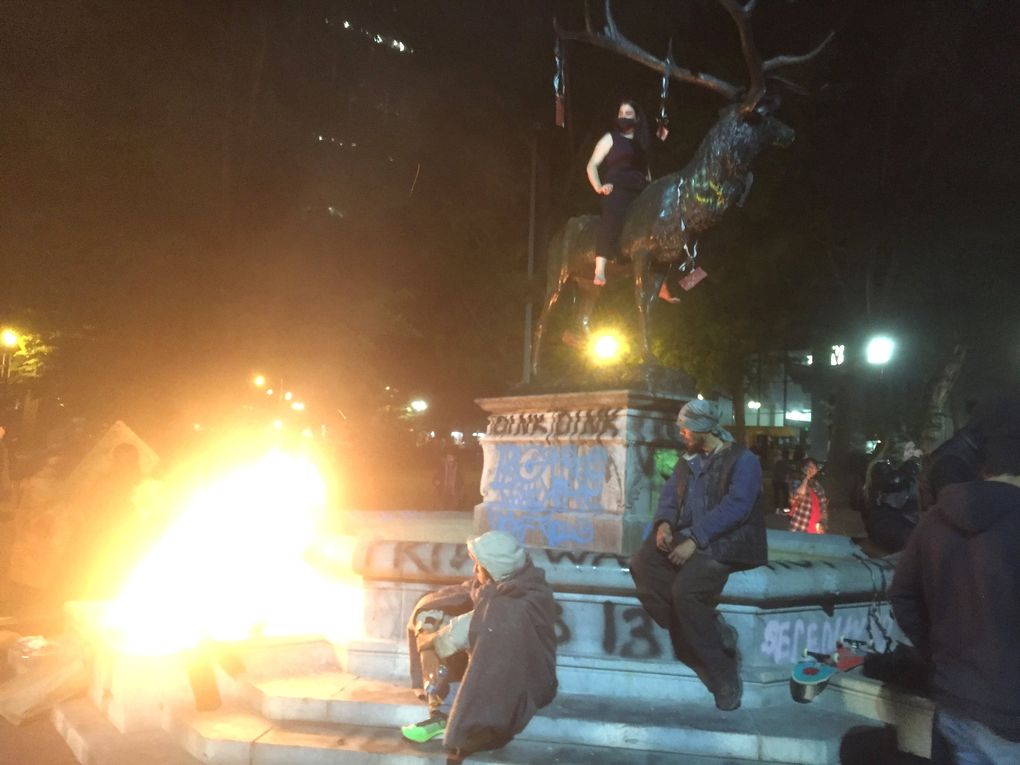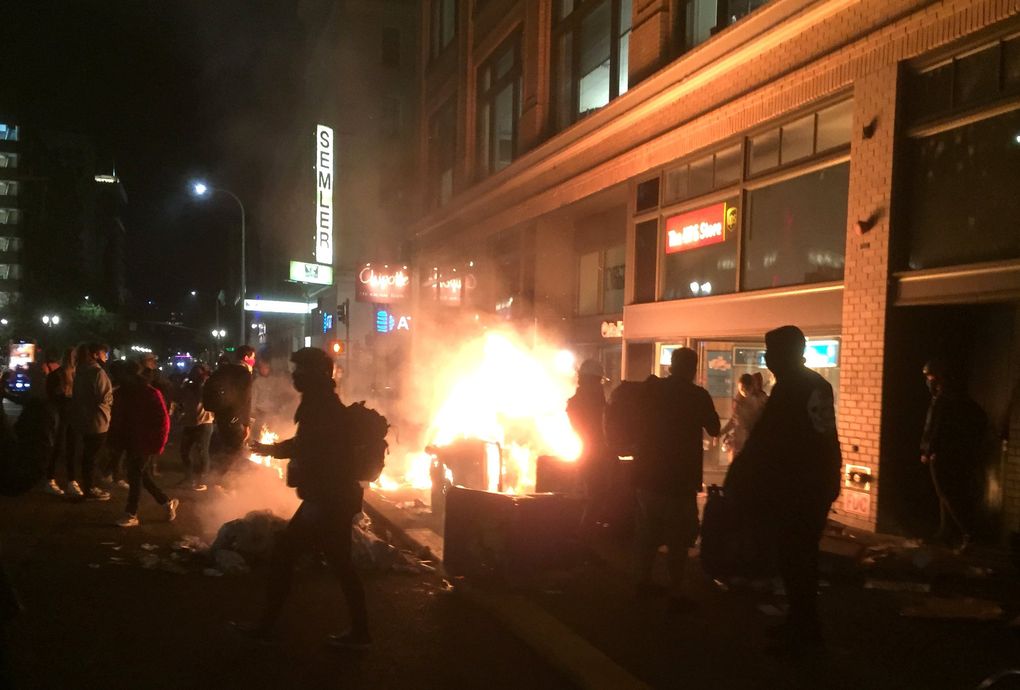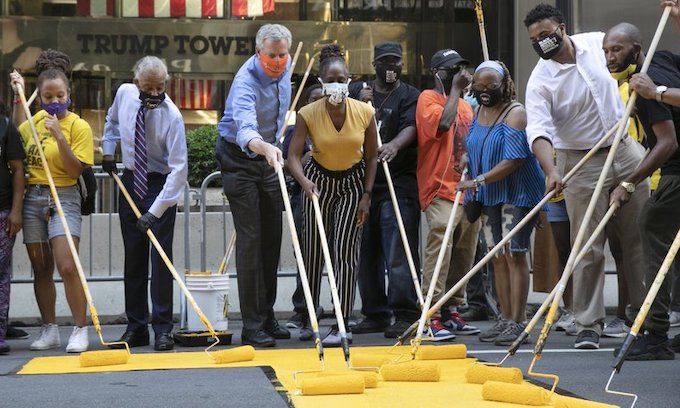PORTLAND — Shortly before 1 a.m. on July 5, as protesters braced for more long hours on the streets in Oregon’s largest city, the Pacific Northwest Youth Liberation Front took to Twitter with a stern declaration.
Be like water, keep moving.
If you see someone smashing windows, shut the (expletive) up.
Walk, don’t run. Hold the front and back lines.

Well after protests against police have faded in many American cities, the Pacific Northwest Youth Liberation Front has emerged in Portland as a persistent militant voice, using social media to promote rallies, and offering tactical advice and commentary on gatherings that often have ended in confrontations with the police and arrests.
The conduct they champion has ignited a bitter debate about the direction these protests have taken in an ongoing drama that plays out nightly in front of the Multnomah County Justice Center and later in largely empty streets defined by block after block of boarded-up buildings. The core of downtown — in the aftermath of the coronavirus pandemic and the demonstrations — appears drained of much of the vitality that has long helped to define this Northwest city.

For the Youth Liberation Front’s anonymous leaders, these protests are part of the revolution. They are resolutely anti-capitalist and anti-fascist, and express disdain for those who work for reform within what they view as a failing political system.
In a podcast interview last October, three of their leaders, one of whom identified himself as still in high school, said they were spurred to activism over a range of issues that included climate change, law enforcement misconduct and the rise of right-wing hate groups.
They have affiliates in Seattle and other U.S. cities, and have gained thousands of new social media followers as they launched into promoting protests over the May 25 police killing of George Floyd. Recently on social media, they have displayed a battle-hardened bravado, scornful not just of baby boomers but white millennials who they view as too often unwilling to put their bodies on the line in protests.
A June 18 tweet from the group: “We are a bunch of teenagers armed with ADHD (attention deficit hyperactivity disorder) and yerba mate — we can take a 5 a.m. raid and be back on our feet a few hours later … we’ll be back again and again until every prison is reduced to ashes and every wall to rubble.”
They are by no means the only group that has organized protests in Portland: Big gatherings that attracted tens of thousands of people, and ended peacefully, were largely put together by others.
But they have been among the most outspoken, combining organizing skills and street savvy in what has evolved into a grueling more-than-40-day marathon for protesters and law enforcement officials who often stay on duty until deep into the early morning hours.
In court filings in U.S. District Court, county officials estimate that damage costs to the Justice Center building, as well as a nearby courthouse that on July 3 had 15 more windows shattered, will exceed $284,000. There have been 140 arson fires, most in trash bins, on the streets or sidewalks. But they also included a May 29 fire inside a first-floor office of the Justice Center, a high-rise that includes a county jail.
In July, protesters have focused more attention on the federal courthouse next to the Justice Center. The U.S. Attorney, in a July 6 filing, charged seven protesters with defacing the building and assaulting federal officers.
In Portland’s downtown area on May 29, some protesters joined in looting stores. In the days that followed, they have broken windows in banks, restaurants and other businesses and the glass in four doors of the side entrance to the historic Arlene Schnitzer Concert Hall. Overall, this damage exceeds $4.5 million, according to documents filed by county and city officials in U.S. court.
Statues also have been defaced with graffiti and damaged.
On July 1 protesters lit fires fueled by plywood and pallets around a downtown Portland landmark — the Elk Fountain — located within sight of the Justice Center where police are based. The damage forced the statue’s removal.
In social media posts, Youth Liberation Front leaders portray acts of vandalism as part of the broader struggle to make big changes in America. They reject any effort — by police or other groups — to divide the protest movement into those who are peaceful and those who turn to violence.
“The Pigs are in a PR battle so they say there’s a difference from ‘peaceful’ and nonviolent protesters. When in fact what we are fighting is the ultimate form of violence, making any and all resistance self and community defense,” the Youth Liberation Front tweeted.
In interviews during protests, some youthful participants embraced those views.
“With real change comes a lot of collateral damage,” said one young man who attended a late-night protest and declined to give his name.
Both police and protesters face scrutiny
As the protests wear on, both police and protesters have, on occasion, come under harsh criticism.
On June 26, protesters set a Dumpster on fire and pushed it up to the side of a northeast Portland building that housed minority-owned businesses and a police precinct station, where people were inside and had to contend with an exit door barricaded shut from the outside. Two suspects, an 18-year-old white man and a 22-year-old Black man, have since been arrested.
Video filed by police in court show that this was a controversial action even among protesters on the scene.
“Put that goddamn fire out, that is a Black building, Black business,” said one voice in a video filed by Portland city officials in U.S. District Court and posted online by The Oregonian.
The next day, Black community leaders lined up outside the building to denounce the arson.
“I know whoever was behind this thinks they were doing it — or perhaps are trying to have us think they were doing it — in the names of Black Lives Matter,” said Tony Hopson, president of Self Enhancement Inc., an organization that assists youth in poverty. “We know that it was just the opposite. Not only was it not about Black Lives Matter. It was against Black Lives Matter.”
Portland Mayor Ted Wheeler joined them, calling the arson “blatant criminal violence — violence that is totally unacceptable.”
Less than a week later, police were taking heat from a prominent state politician.
Oregon House Speaker Tina Kotek, a Democrat who represents North Portland, lashed out at them for “the utter inability to exercise restraint” in a response to a July 1 protest in her district. In front of a police union building, officers used tear gas that spread to motorists despite a U.S. District Court restraining order restricting its use to times when life and safety are at risk. The police also arrested three journalists, and Kotek said the police conduct represented an unnecessary escalation against people exercising their freedom of assembly.
In response, Daryl Turner, union president of the Portland Police Association and who is Black, accused “a small number of individuals” of having “hijacked the racial equity platform of peaceful protests.” In a follow-up statement, Turner declared their “destructive and chaotic behavior defines the meaning of white privilege.”
Chris Davis, a deputy chief of the Portland Police Bureau, at a July 8 briefing with reporters, said that officers have been pushed longer and harder than he has ever seen during what he termed an “unprecedented” stretch of protests that have injured more than 100 people, including police.
Davis said police have been hit with frozen water bottles, rocks and other objects, had paintballs spatter their face shields, and been harassed with laser lights that can damage eyesight. He said there are still no excuses for police failing to live up to the organization’s standards, and some conduct concerns have been referred to an independent review and the bureau’s professional standards commission.
Legacy and new prominence
The Youth Liberation Front, from early on, has favored secrecy. The group’s leadership appears to embrace the radical Northwest legacy of the “black bloc” whose acts of vandalism roiled the 1999 Seattle protests during a meeting of the World Trade Organization.
The group launched a Twitter account in May 2018, and gained more prominence in September of 2019 as its members helped organize a walk out of Portland high school students to draw attention to climate change.
The next month, three of the leaders — two young men and a young woman — spoke anonymously in a podcast produced by It’s Going Down, a “digital community center for anarchist, anti-fascist … anti-capitalist and anti-colonial movements.”
In the podcast they talked about how they brought 250 masks to a September climate march, where they helped persuade peers — skittish about identifying with anarchists, black bloc and the anti-fascist movement — to shield their identities and join their fight.
“There are a lot of youth … who have the idea of … anti-capitalism, anti-racism already in their mind,” said an organizer. “But the idea of like Antifa, the idea of masking up is what scares them away … What we did with the climate strike is let them know that we don’t do this to be intimidating or threatening. We do it to protect ourselves and show solidarity.”
By the time Portland joined in the nationwide protests against George Floyd, the Youth Liberation Front was adept at mobilizing its supporters. But as its social media following grew, as did its reputation, it drew new scrutiny from within the activist community.
“Lots of folks have been reaching out concerned that we’re putting our majority white voices over POC (people of color) organizers that have been doing this work longer than us all,” said a June 7 post on the group’s Facebook page. “I apologize for the lack of communication and transparency on our part, and there is really not an excuse … all we can do is learn from mistakes and the criticisms from the community, and grow as people.”
The group did not respond to an email request from The Seattle Times for an interview.
A ‘Night of Rage’
In Portland, the evening of July 7 was billed in a Pacific Northwest Liberation Front Facebook post and tweet as a “Night of Rage for Summer Taylor,” a solidarity vigil in front of the Justice Center .
Taylor, 24, who was drawn to work at a veterinary clinic by a love of animals, was killed during a protest in Seattle earlier this month by a man who maneuvered his car onto a closed stretch of Interstate 5, drove around barriers and barreled into demonstrators. Another person was seriously injured.
The driver, Dawit Kelete, is charged with vehicular homicide, vehicular assault and reckless driving. He told jail officials he was withdrawing from Percocet and struggled with “untreated addictions.”
The protest of July 7 unfolded in an uneasy mix of suspicion and reflection.
Several of the early speakers got a cool reception from some of those gathered near the Justice Center. They hadn’t been to some of the earlier downtown protests, and were thought to be trying to tamp down the militancy of the movement, several protesters told a reporter.
In a nearby park, people gathered around a circle of candles lit in memory of the lost life. There was a moment of silence as a banner was held up that declared “Rest in Power in Summer Taylor.”
Then, some of the protesters picked up a familiar refrain “ACAB” — or All Cops are Bastards — and another that linked Mayor Wheeler’s name to an obscenity.
A woman opted out of the chants. “It’s not about Ted Wheeler. It’s not about the police. That’s not the reality of what happened to Summer Taylor.”
About 15 minutes before midnight, federal law enforcement officials made a brief appearance, firing two flash bangs, then retreating into a building. The crowd reacted like someone had poked a stick into a beehive, hurling insults that would continue deep into the night.




/https://public-media.si-cdn.com/filer/f8/c7/f8c78213-1434-40c9-bcd7-ef541f06f19d/tonightwebombedtheuscapitol_to_17_runningonempty1.jpg)
